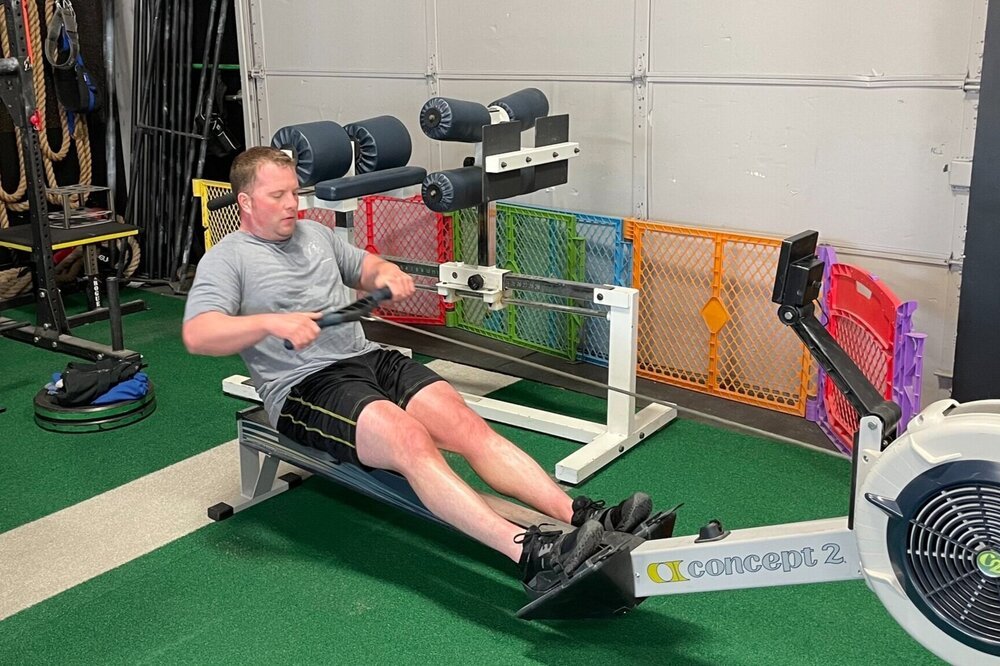The BEST Conditioning Tool NOBODY Uses (Starting Strength and Cardio?)
/What’s the best conditioning tool that nobody uses?
It just might be the rower.
You know what I mean - you go to your local globo gym, and there’s 15 treadmills, 20 ellipticals, 5 steppers, there’s a few bikes, and people are using all of them.
Then, over in the corner, you see one rower. And it’s lonely. It’s always lonely.
This is terribly unfortunate because the rower is a powerful and effective conditioning tool, so let’s quickly discuss why this is so, how to schedule it within the context of your strength training, and let’s cover some sample workouts as well.
Why is the rower such an effective conditioning tool?
The rower (AKA ergometer or simply erg) is effective because it does not have a loaded eccentric phase.
No worries if you’re not sure what that means - no one else is, either, so let’s quickly cover it.
Take an air squat (i.e., a squat with only your bodyweight for resistance), for example. If you do 100-200 reps of those, there’s a solid chance you’re going to have some significant soreness the next day or so, and this is because the eccentric phase (the descent of the squat) is loaded, i.e., gravity pulls on your body and thus pulls you downward. You have to resist the load of your own bodyweight - otherwise, you’d collapse down onto the floor.
It turns out that it’s this loaded aspect of the eccentric phase that causes the soreness.
In rowing, the equivalent of the squat’s descent is called the recovery, and it’s when you pull yourself back to the starting position, or the “catch” position. Here’s the key part - unlike the squat, wherein gravity pulls you down, in rowing, you have to pull yourself back to this position. Thus the eccentric phase is not loaded, which means 20 minutes of hard rowing doesn’t wreck you the same way that 20 minutes of air squats does.
As a side note, both biking and pushing a prowler or sled are good options as well as they, too, lack a loaded eccentric phase.
When to schedule your rowing
Let’s make a few assumptions here. Not all of these will apply to everyone, of course, but they will help us understand the key concepts.
You strength train on Monday, Wednesday, and Friday.
You plan to condition twice a week.
You plan to row for both of those conditioning sessions (you can certainly have more variety here, but this is a rowing article, after all)
For starters, put one of your two conditioning days on Saturday. It’s separate from your strength training days, and you still get to rest on Sunday before hitting the strength training again on Monday.
You have a couple options for your other conditioning day:
Row immediately after you perform your strength training on Monday or Wednesday. The upside is that you’re already at the gym, and the downside is that it makes for a longer training session.
If you’ve reached the point where you have a light squat day on Wednesday, then you could row on Tuesday. The upside here is that it doesn’t add training time to any of your strength training days, and the downside is that you have to drive to the gym an additional day (unless you have a home gym).
Both options are reasonable, so you simply need to decide on the tradeoffs you’re willing to accept. The two principles in play are that you don’t want your rowing to derail your strength training, and you’d also like the schedule to be as manageable as possible from a time and convenience perspective (consistency is key, and most people will start skipping sessions if the schedule is too inconvenient).
Now, let’s dive into a few sample workouts, and if you’d like more workouts, you can head over to this article.
Workout #1
3 rounds of:
8 x 20 sec on/40 sec off
Rest 3 min between each round.
Score = least distance covered in any 20 second interval
For this workout, row for 20 seconds, then rest 40 seconds (thus the rowing and resting periods add up to 1 minute), and repeat this sequence for 8 minutes. These 8 minutes comprise round 1.
Rest 3 minutes, perform round 2, rest another 3 minutes, perform round 3, and you’re done. You are trying to cover as much distance in each 20 second interval, but your score is your lowest distance, so you are also aiming for consistency.
Workout #2
4 rounds of:
800m
Rest 3 minutes between each round.
Score = slowest time
For this workout, row 800 meters, rest 3 minutes, and repeat this for 4 rounds. You are gunning for fast times, but your score is your slowest time, so again, consistency is rewarded.
Workout #3
8 rounds of:
30 sec on/2:00 off
Score = least distance covered in any 30 second interval
For this workout, row for 30 seconds, then rest 2 minutes, and repeat this for 8 rounds.
If you are just starting out with your conditioning, be conservative at first - you don’t want your enthusiasm to derail your strength training.
As always, we hope this helps you get stronger - or in this case better conditioned - and live better.
-Phil
PS: Whenever you want even more Testify in your life, here are some free resources:
Book a free intro and strategy session with us HERE.
Pick up a free copy of Testify’s Squat Guide: 12 Tips to Improve Your Squat Now HERE.
Get our free weekly email - containing useful videos, articles, and training tips - HERE.
Follow Testify on Instagram HERE.
Subscribe to Testify’s YouTube channel HERE.
(Some links may be affiliate links. As an Amazon Associate, Testify earns from qualifying purchases.)












